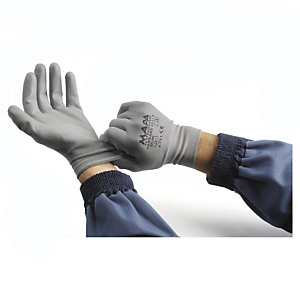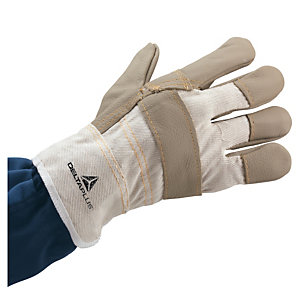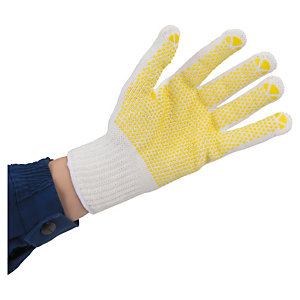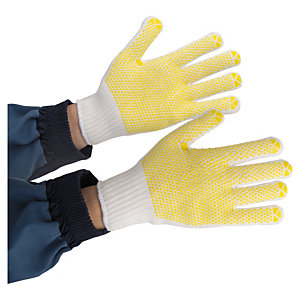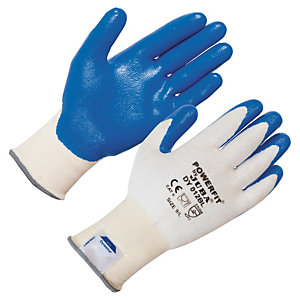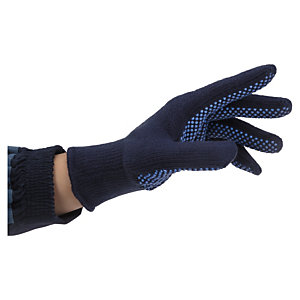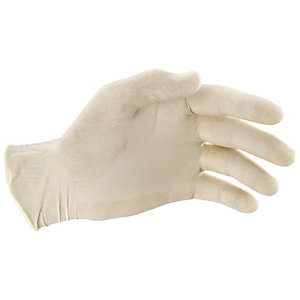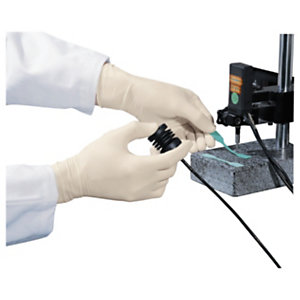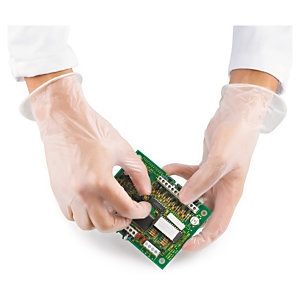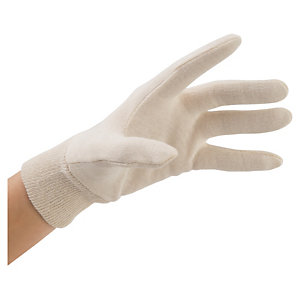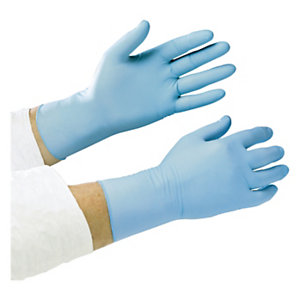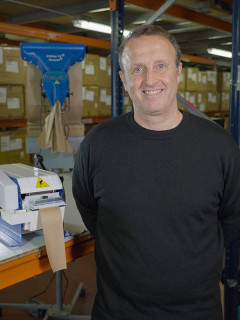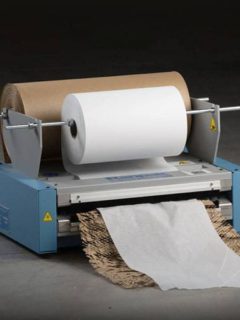In the workplace, hand injuries are very common as hands are in constant use and are also the first source of contamination by viruses and chemicals. Properly chosen gloves can solve these problems, such as cutting yourself on a sharp object or coming into direct contact with chemicals. We will help you find the right glove type and size for you with this guide. Trust an expert!
► Step 1: How do I know what size gloves I need?
choose the right size for your gloves. It is very important to choose the right size glove for your hand because only in this way you will be fully protected. Moreover, by choosing the right size you gain in comfort and dexterity. To know the right size for your gloves you need two things: your useful hand and a tape measure.Just turn the tape measure around the widest point of your hand (usually the knuckles). These are the standard sizes that you can find
| Glove size | Hand circumference (mm) | Hand length (mm) | Minimum glove length (mm) |
| 6 | 152 | 160 | 220 |
| 7 | 178 | 171 | 240 |
| 8 | 203 | 182 | 250 |
| 9 | 229 | 192 | 260 |
| 10 | 254 | 204 | 270 |
| 11 | 279 | 215 | 280 |
source: Ministry of Labour and Social Affairs and the National Institute for Safety and Hygiene at WorkThe size of a glove is always expressed in inches. If your hand is between two sizes, always choose the smaller one: Protective gloves must always fit snugly and get bigger over time. If you don’t have a tape measure handy, on page 336 of our catalogue you can check your measurement by placing your hand on top of the diagram drawn
► Step 2: How do I choose the right protective gloves?
you have chosen the right size, now you have to decide which safety gloves are the most suitable for your work. The international symbols shown below will help you a lot:
► CE certification
 CE stands for Conformité Européenne and is awarded to products that comply with European regulations. These rules apply, among other things, to electrical appliances, toys and personal protective equipment. To know the truthfulness of this mark you have to keep in mind that it must always be legible, visible and indelible
CE stands for Conformité Européenne and is awarded to products that comply with European regulations. These rules apply, among other things, to electrical appliances, toys and personal protective equipment. To know the truthfulness of this mark you have to keep in mind that it must always be legible, visible and indelible
► European Standard for protective gloves ⇒ Standard EN 420
 This European standard describes some basic requirements for protective gloves. This refers, for example, to the fact that
This European standard describes some basic requirements for protective gloves. This refers, for example, to the fact that
- Work gloves must not contain substances that can cause allergies.
- Gloves must be designed according to the European hand size.
- The pH values should always be as neutral as possible.
► Do you work with machines? ⇒ Standard EN 388
this symbol indicates work gloves that protect against mechanical risks: blade cutting, tearing, sanding and even drilling. The pictogram shown below symbolises the protection against mechanical risks that a glove can give you, you will see in 4 digits a representation of the performance levels. These are expressed from 0 (low protection) to 4 or 5 (the highest protection). If instead of a number you see an X, this means that this performance measurement does not apply to the glove. Some of the gloves that you can find that are suitable in this standard are
Some of the gloves that you can find that are suitable in this standard are
| Name | Advantages | Examples of use |
| Ultrane gloves
|
Resistant: For mechanical and handling work.Comfortable: Seamless polyamide, coated with polyurethane foam. Non-slip on fingers and palm. Flexible and breathable. Elasticated cuff. | Assembly work, electronics.. |
| Docker gloves
|
Cotton and leather.Flexible: white fabric back and cuff, pigmented split leather palm. | Maintenance, storage, stevedoring, transport work.. |
| Gloves with PVC spikes (only on palm)
|
Anti-slip: PVC dots on the palm of the handResistant and ergonomic: Made of polyester and cotton. Machine washable | Cleaning, logistics, packaging.. |
| Gloves with PVC spikes (on both sides)
|
Non-slip: PVC dots finish.Resistant and ergonomic: Made of polyester and cotton. Machine washable. | Cleaning, loading and unloading, maritime transport.. |
| Fibre gloves
|
Resistant: Maximum protection against cuts and abrasion. Washable.High performance: Fibre glove with blue waterproof nitrile coating. Suitable for gripping materials in wet or oily conditions. Suitable for food use.No allergies due to latex. | Agriculture, food handling.. |
| Thermal gloves
|
Thermal insulation: Made of seamless synthetic fibre, double vulrizo interior. Keeps hand temperature stable in moderate cold conditions.Non-slip: PVC dots finish. | Frozen or refrigerated food handling, maintenance, logistics.. |
do you work with chemicals or micro-organisms? ⇒ Standard EN 374
if you are in contact with chemicals or micro-organisms, you should only use gloves with the pictograms you can see below. This pictogram indicates the chemical against which the glove offers protection.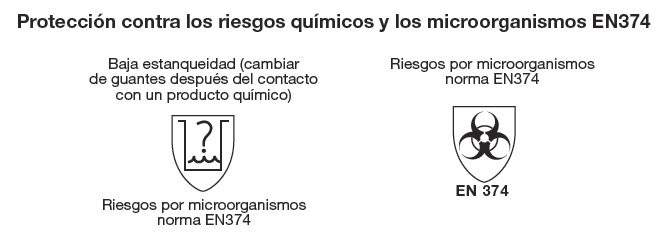 For gloves that protect against micro-organisms, you can choose from the following materials
For gloves that protect against micro-organisms, you can choose from the following materials
| Name | Advantages | Examples of use |
| Latex gloves
|
Protection adapted to short-term use.Comfortable to wear: natural latex with powdered interior and good wet and dry grip.Hygienic: Suitable for food handling Very comfortable and lightweight. highly elastic. | Laboratories, pharmaceutical, chemical and electronics industries.. |
► Step 3: Do I have to choose powdered gloves?
in addition to the size of a glove, you should know whether your industry allows gloves with powder inside or not. Many gloves, such as disposable gloves made of latex, vinyl or nitrile (more on these later), have added corn starch powder that helps you put the gloves on and take them off more easily. Moisture and sweat are absorbed faster thanks to this powder. This makes these gloves very comfortable to wear, but they are not always recommended: In the food industry or in a clinical environment, for example, you should avoid mixing corn starch with the products
► Step 4: How do I choose the right gloves for working with delicate and/or small products?
when working with very delicate products, such as glass, jewellery or fine electronics, you should choose these types
| Name | Advantages | Examples of use |
| MAPA latex gloves only
|
Protection adapted to shortterm use .Comfortable to wear: Natural latex with powdered inside, with very good grip both wet and dry.Hygienic: Suitable for food handling | Laboratories, small dirty maintenance, printing, non-sterile medical treatment.. |
| Vinyl gloves
|
Disposable: Single use glove, made of high quality vinyl. Natural colour. Powdered inside.Long life: 5 years from date of manufacture. Suitable for food use. | Fine and delicate handling, jewellery polishing, precision assembly, laboratory work, catering kitchen, work with paints, inks, dyes and epoxy resins, hairdressing salons. |
► Step 5: Which gloves are suitable for small risks?
perfect gloves for handling things neatly
| Name | Advantages | Examples of use |
| Cotton interlock gloves
|
Clean: Avoid finger marks and dirt.Practical: Hemmed cuffs. Can be used alone or under another glove. Made of cotton. | Handling of delicate parts, detailed finishing operations, photo laboratories.. |
| Nitrile gloves
|
Disposable: single-use glove, made of 100% blue nitrile. Powder-free.Comfortable: cuff with piping.Long-lasting: 3 years from date of manufacture.Micro-rough.Suitable for food use. | Fine and delicate handling, jewellery polishing, precision assembly, laboratory work, public kitchens, hairdressing, food preparation, very dirty and not very aggressive work, veterinary, laboratories and non-sterile medical examinations and treatments. |
at Rajapack we are experts in packaging, so if you want to buy gloves and have any doubts, you have landed in the perfect place, call 902 20 30 06. Remember that we deliver in 24/48h to the whole peninsula. You can also visit our website:











